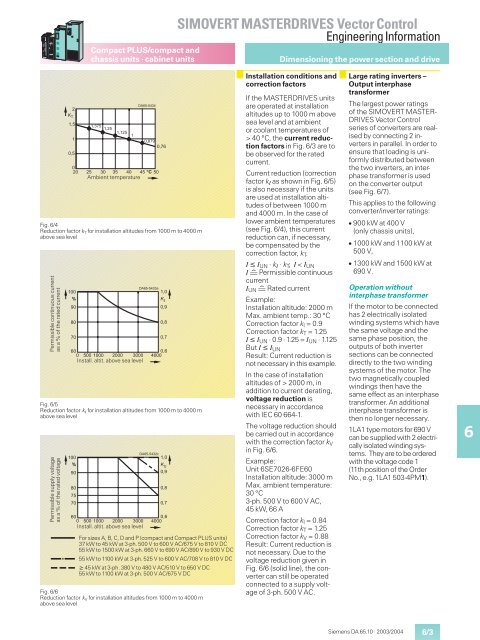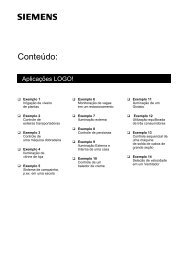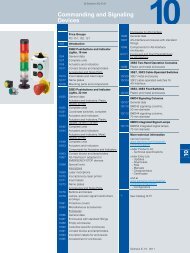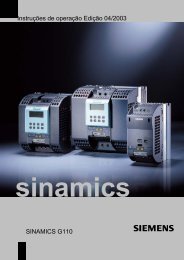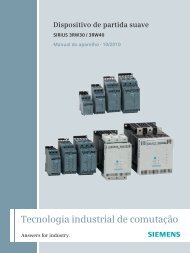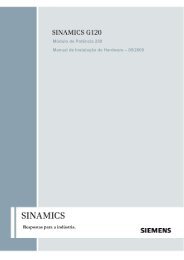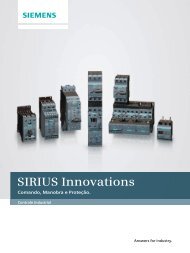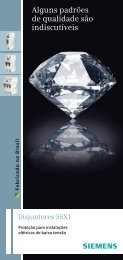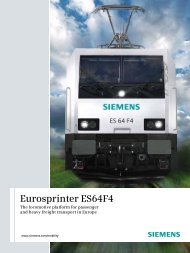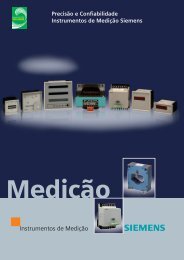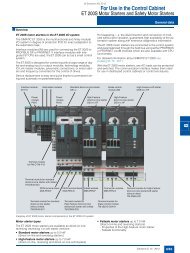- Page 1:
Catalog DA 65.10 • 2003/2004vecto
- Page 5:
Vector ControlOverview11/2 Applicat
- Page 8 and 9:
1SIMOVERT MASTERDRIVES Vector Contr
- Page 10 and 11:
1SIMOVERT MASTERDRIVES Vector Contr
- Page 12 and 13:
1OverviewSIMOVERT MASTERDRIVES Vect
- Page 14 and 15:
SIMOVERT MASTERDRIVES Vector Contro
- Page 16 and 17:
SIMOVERT MASTERDRIVES Vector Contro
- Page 18 and 19:
SIMOVERT MASTERDRIVES Vector Contro
- Page 20 and 21:
SIMOVERT MASTERDRIVES Vector Contro
- Page 22 and 23:
SIMOVERT MASTERDRIVES Vector Contro
- Page 24 and 25:
SIMOVERT MASTERDRIVES Vector Contro
- Page 26 and 27:
SIMOVERT MASTERDRIVES Vector Contro
- Page 28 and 29:
SIMOVERT MASTERDRIVES Vector Contro
- Page 30 and 31:
SIMOVERT MASTERDRIVES Vector Contro
- Page 32 and 33:
SIMOVERT MASTERDRIVES Vector Contro
- Page 34 and 35:
SIMOVERT MASTERDRIVES Vector Contro
- Page 36 and 37:
SIMOVERT MASTERDRIVES Vector Contro
- Page 38 and 39:
SIMOVERT MASTERDRIVES Vector Contro
- Page 40 and 41:
SIMOVERT MASTERDRIVES Vector Contro
- Page 42 and 43:
SIMOVERT MASTERDRIVES Vector Contro
- Page 44 and 45:
SIMOVERT MASTERDRIVES Vector Contro
- Page 46 and 47:
SIMOVERT MASTERDRIVES Vector Contro
- Page 48 and 49:
SIMOVERT MASTERDRIVES Vector Contro
- Page 50 and 51:
SIMOVERT MASTERDRIVES Vector Contro
- Page 52 and 53:
SIMOVERT MASTERDRIVES Vector Contro
- Page 54 and 55:
SIMOVERT MASTERDRIVES Vector Contro
- Page 56 and 57:
SIMOVERT MASTERDRIVES Vector Contro
- Page 58 and 59:
SIMOVERT MASTERDRIVES Vector Contro
- Page 60:
SIMOVERT MASTERDRIVES Vector Contro
- Page 63 and 64:
Compact and chassis unitsSIMOVERT M
- Page 65 and 66:
Compact and chassis unitsSIMOVERT M
- Page 67 and 68:
Technical dataCompact PLUS unitsCom
- Page 69 and 70:
Compact PLUS unitsCompact and chass
- Page 71 and 72:
Compact PLUS unitsCompact and chass
- Page 73 and 74:
Compact PLUS unitsCompact and chass
- Page 75 and 76:
Compact PLUS unitsCompact and chass
- Page 77 and 78:
Compact and chassis unitsSIMOVERT M
- Page 79 and 80:
Compact PLUS unitsSIMOVERT MASTERDR
- Page 81 and 82:
Compact and chassis unitsSIMOVERT M
- Page 83 and 84:
Compact and chassis unitsSIMOVERT M
- Page 85 and 86:
Compact and chassis unitsSIMOVERT M
- Page 87 and 88:
Compact and chassis unitsSIMOVERT M
- Page 89 and 90:
Compact and chassis unitsSIMOVERT M
- Page 91 and 92:
Compact and chassis unitsSIMOVERT M
- Page 93 and 94:
Compact and chassis unitsSIMOVERT M
- Page 95 and 96:
Compact PLUS unitsCompact and chass
- Page 97 and 98:
Compact PLUS unitsCompact and chass
- Page 99 and 100:
Compact and chassis unitsSIMOVERT M
- Page 101 and 102:
Compact and chassis unitsSIMOVERT M
- Page 103 and 104:
SIMOVERT MASTERDRIVES Vector Contro
- Page 105 and 106:
Compact and chassis unitsSIMOVERT M
- Page 107 and 108:
Compact PLUS unitsCompact and chass
- Page 109 and 110:
Compact PLUS unitsCompact and chass
- Page 111 and 112:
Compact PLUS unitsCompact and chass
- Page 113 and 114:
Compact PLUS unitsCompact and chass
- Page 115 and 116:
SIMOVERT MASTERDRIVES Vector Contro
- Page 117 and 118:
SIMOVERT MASTERDRIVES Vector Contro
- Page 119 and 120:
Compact PLUS unitsCompact and chass
- Page 121 and 122:
Compact PLUS unitsCompact and chass
- Page 123 and 124:
Vector Control6SE71ConverterCabinet
- Page 125 and 126:
SIMOVERT MASTERDRIVES Vector Contro
- Page 127 and 128: Cabinet unitsSIMOVERT MASTERDRIVES
- Page 129 and 130: Cabinet unitsSIMOVERT MASTERDRIVES
- Page 131 and 132: Cabinet unitsSIMOVERT MASTERDRIVES
- Page 133 and 134: Cabinet unitsSIMOVERT MASTERDRIVES
- Page 135 and 136: Cabinet unitsSIMOVERT MASTERDRIVES
- Page 137 and 138: Cabinet unitsSIMOVERT MASTERDRIVES
- Page 139 and 140: Cabinet unitsSIMOVERT MASTERDRIVES
- Page 141 and 142: Cabinet unitsSIMOVERT MASTERDRIVES
- Page 143 and 144: Cabinet unitsSIMOVERT MASTERDRIVES
- Page 145 and 146: Cabinet unitsSIMOVERT MASTERDRIVES
- Page 147 and 148: Cabinet unitsSIMOVERT MASTERDRIVES
- Page 149 and 150: SIMOVERT MASTERDRIVES Vector Contro
- Page 151 and 152: SIMOVERT MASTERDRIVES Vector Contro
- Page 153 and 154: SIMOVERT MASTERDRIVES Vector Contro
- Page 155 and 156: SIMOVERT MASTERDRIVES Vector Contro
- Page 157 and 158: SIMOVERT MASTERDRIVES Vector Contro
- Page 159 and 160: SIMOVERT MASTERDRIVES Vector Contro
- Page 161 and 162: SIMOVERT MASTERDRIVES Vector Contro
- Page 163 and 164: SIMOVERT MASTERDRIVES Vector Contro
- Page 165 and 166: SIMOVERT MASTERDRIVES Vector Contro
- Page 167 and 168: SIMOVERT MASTERDRIVES Vector Contro
- Page 169 and 170: Vector ControlDocumentationand Trai
- Page 171 and 172: Compact PLUS unitsCompact and chass
- Page 173 and 174: SIMOVERT MASTERDRIVES Vector Contro
- Page 175 and 176: Compact PLUS/compact andchassis uni
- Page 177: Vector ControlEngineeringInformatio
- Page 181 and 182: Compact and chassis unitsCabinet un
- Page 183 and 184: Compact PLUS/compact andchassis uni
- Page 185 and 186: Compact PLUS/compact andchassis uni
- Page 187 and 188: Compact PLUS/compact andchassis uni
- Page 189 and 190: Compact PLUS/compact andchassis uni
- Page 191 and 192: SIMOVERT MASTERDRIVES Vector Contro
- Page 193 and 194: Compact and chassis unitsCabinet un
- Page 195 and 196: Compact and chassis unitsCabinet un
- Page 197 and 198: Compact and chassis unitsCabinet un
- Page 199 and 200: Compact and chassis unitsSIMOVERT M
- Page 201 and 202: Compact and chassis unitsSIMOVERT M
- Page 203 and 204: Compact PLUS unitsSIMOVERT MASTERDR
- Page 205 and 206: Compact PLUS/compact andchassis uni
- Page 207 and 208: Compact PLUS/compact andchassis uni
- Page 209 and 210: Compact PLUS/compact andchassis uni
- Page 211 and 212: Compact PLUS unitsSIMOVERT MASTERDR
- Page 213 and 214: Compact PLUS unitsSIMOVERT MASTERDR
- Page 215 and 216: Compact and chassis unitsCabinet un
- Page 217 and 218: Compact and chassis unitsCabinet un
- Page 219 and 220: Compact and chassis unitsCabinet un
- Page 221 and 222: Compact and chassis unitsCabinet un
- Page 223 and 224: Compact and chassis unitsCabinet un
- Page 225 and 226: Compact and chassis unitsCabinet un
- Page 227 and 228: Compact PLUS/compact andchassis uni
- Page 229 and 230:
SIMOVERT MASTERDRIVES Vector Contro
- Page 231 and 232:
Compact and chassis unitsCabinet un
- Page 233 and 234:
Compact PLUS/compact andchassis uni
- Page 235 and 236:
Compact PLUS/compact andchassis uni
- Page 237 and 238:
Compact PLUS/compact andchassis uni
- Page 239 and 240:
Compact PLUS/compact andchassis uni
- Page 241 and 242:
Compact PLUS/compact andchassis uni
- Page 243 and 244:
Compact PLUS/compact andchassis uni
- Page 245 and 246:
Compact and chassis unitsCabinet un
- Page 247 and 248:
Compact and chassis unitsCabinet un
- Page 249 and 250:
Compact and chassis unitsCabinet un
- Page 251 and 252:
Compact and chassis unitsCabinet un
- Page 253 and 254:
Compact and chassis unitsCabinet un
- Page 255 and 256:
Compact and chassis unitsCabinet un
- Page 257 and 258:
Compact and chassis unitsCabinet un
- Page 259 and 260:
Compact and chassis unitsCabinet un
- Page 261 and 262:
Compact and chassis unitsCabinet un
- Page 263 and 264:
Vector ControlDimensionDrawings7/2
- Page 265 and 266:
fSIMOVERT MASTERDRIVES Vector Contr
- Page 267 and 268:
SIMOVERT MASTERDRIVES Vector Contro
- Page 269 and 270:
Compact and chassis unitsSIMOVERT M
- Page 271 and 272:
Compact PLUS/compact andchassis uni
- Page 273 and 274:
Compact PLUS/compact andchassis uni
- Page 275 and 276:
Compact and chassis unitsCabinet un
- Page 277 and 278:
tCompact PLUS/compact andchassis un
- Page 279 and 280:
Compact and chassis unitsCabinet un
- Page 281 and 282:
Compact PLUS/compact andchassis uni
- Page 283 and 284:
Compact PLUS/compact andchassis uni
- Page 285 and 286:
Cabinet unitsSIMOVERT MASTERDRIVES
- Page 287 and 288:
Cabinet unitsSIMOVERT MASTERDRIVES
- Page 289 and 290:
Cabinet unitsSIMOVERT MASTERDRIVES
- Page 291 and 292:
Cabinet unitsSIMOVERT MASTERDRIVES
- Page 293 and 294:
Cabinet unitsSIMOVERT MASTERDRIVES
- Page 295 and 296:
Cabinet unitsSIMOVERT MASTERDRIVES
- Page 297 and 298:
Cabinet unitsSIMOVERT MASTERDRIVES
- Page 299 and 300:
Cabinet unitsSIMOVERT MASTERDRIVES
- Page 301 and 302:
Cabinet unitsSIMOVERT MASTERDRIVES
- Page 303 and 304:
Cabinet unitsSIMOVERT MASTERDRIVES
- Page 305 and 306:
Cabinet unitsSIMOVERT MASTERDRIVES
- Page 307 and 308:
Cabinet unitsSIMOVERT MASTERDRIVES
- Page 309 and 310:
Cabinet unitsSIMOVERT MASTERDRIVES
- Page 311 and 312:
Cabinet unitsSIMOVERT MASTERDRIVES
- Page 313 and 314:
Cabinet unitsSIMOVERT MASTERDRIVES
- Page 315 and 316:
Cabinet unitsSIMOVERT MASTERDRIVES
- Page 317 and 318:
Cabinet unitsSIMOVERT MASTERDRIVES
- Page 319 and 320:
Vector ControlAppendixA/2 Certifica
- Page 321 and 322:
Compact PLUS/compact andchassis uni
- Page 323 and 324:
Compact PLUS/compact andchassis uni
- Page 325 and 326:
Compact PLUS/compact andchassis uni
- Page 327 and 328:
Compact PLUS/compact andchassis uni
- Page 329 and 330:
Compact PLUS/compact andchassis uni
- Page 331 and 332:
Catalogs of theAutomation and Drive


